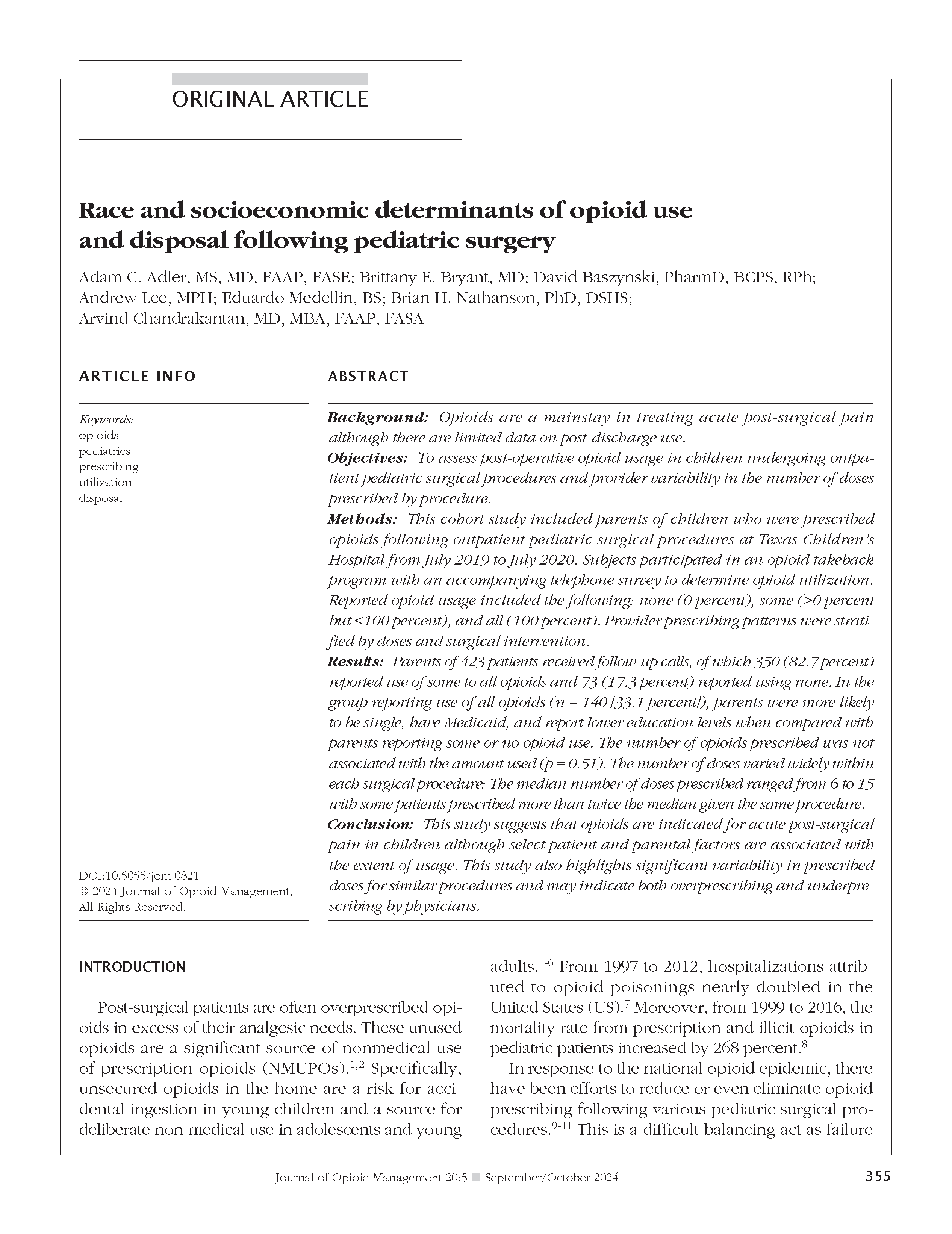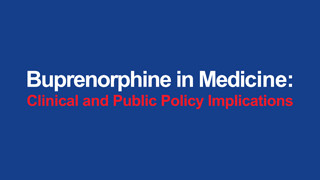Race and socioeconomic determinants of opioid use and disposal following pediatric surgery
DOI:
https://doi.org/10.5055/jom.0821Keywords:
opioids, pediatrics, prescribing, utilization, disposalAbstract
Background: Opioids are a mainstay in treating acute post-surgical pain although there are limited data on post-discharge use.
Objectives: To assess post-operative opioid usage in children undergoing outpatient pediatric surgical procedures and provider variability in the number of doses prescribed by procedure.
Methods: This cohort study included parents of children who were prescribed opioids following outpatient pediatric surgical procedures at Texas Children's Hospital from July 2019 to July 2020. Subjects participated in an opioid takeback program with an accompanying telephone survey to determine opioid utilization. Reported opioid usage included the following: none (0 percent), some (>0 percent but <100 percent), and all (100 percent). Provider prescribing patterns were stratified by doses and surgical intervention.
Results: Parents of 423 patients received follow-up calls, of which 350 (82.7 percent) reported use of some to all opioids and 73 (17.3 percent) reported using none. In the group reporting use of all opioids (n = 140 [33.1 percent]), parents were more likely to be single, have Medicaid, and report lower education levels when compared with parents reporting some or no opioid use. The number of opioids prescribed was not associated with the amount used (p = 0.51). The number of doses varied widely within each surgical procedure: The median number of doses prescribed ranged from 6 to 15 with some patients prescribed more than twice the median given the same procedure.
Conclusion: This study suggests that opioids are indicated for acute post-surgical pain in children although select patient and parental factors are associated with the extent of usage. This study also highlights significant variability in prescribed doses for similar procedures and may indicate both overprescribing and underprescribing by physicians.
References
Chung CP, Callahan ST, Cooper WO, et al.: Outpatient opioid prescriptions for children and opioid-related adverse events. Pediatrics. 2018; 142(2). DOI: 10.1542/peds.2017-2156. DOI: https://doi.org/10.1542/peds.2017-2156
McCabe SE, West BT, Boyd CJ: Leftover prescription opioids and nonmedical use among high school seniors: A multi-cohort national study. J Adolescent Health. 2013; 52(4): 480-485. DOI: 10.1016/j.jadohealth.2012.08.007. DOI: https://doi.org/10.1016/j.jadohealth.2012.08.007
Voepel-Lewis T, Wagner D, Tait AR: Leftover prescription opioids after minor procedures: An unwitting source for accidental overdose in children. JAMA Pediatr. 2015; 169(5): 497-498. DOI: 10.1001/jamapediatrics.2014.3583. DOI: https://doi.org/10.1001/jamapediatrics.2014.3583
Kane JM, Colvin JD, Bartlett AH, et al.: Opioid-related critical care resource use in US children's hospitals. Pediatrics. 2018; 141(4). DOI: 10.1542/peds.2017-3335. DOI: https://doi.org/10.1542/peds.2017-3335
Monitto CL, Hsu A, Gao S, et al.: Opioid prescribing for the treatment of acute pain in children on hospital discharge. Anesth Analgesia. 2017; 125(6): 2113-2122. DOI: 10.1213/ane.0000000000002586. DOI: https://doi.org/10.1213/ANE.0000000000002586
Allen JD, Casavant MJ, Spiller HA, et al.: Prescription opioid exposures among children and adolescents in the United States: 2000-2015. Pediatrics. 2017; 139(4). DOI: 10.1542/peds.2016-3382. DOI: https://doi.org/10.1542/peds.2016-3382
Gaither JR, Leventhal JM, Ryan SA, et al.: National trends in hospitalizations for opioid poisonings among children and adolescents, 1997 to 2012. JAMA Pediatr. 2016; 170(12): 1195-1201. DOI: 10.1001/jamapediatrics.2016.2154. DOI: https://doi.org/10.1001/jamapediatrics.2016.2154
Gaither JR, Shabanova V, Leventhal JM: US national trends in pediatric deaths from prescription and illicit opioids, 1999-2016. JAMA Netw Open. 2018; 1(8): e186558. DOI: 10.1001/jamanetworkopen.2018.6558. DOI: https://doi.org/10.1001/jamanetworkopen.2018.6558
Cardona-Grau D, Bush RA, Le HK, et al.: Reducing opioid prescriptions in outpatient pediatric urological surgery. J Urol. 2019; 201(5): 1012-1016. DOI: 10.1097/ju.0000000000000020. DOI: https://doi.org/10.1097/JU.0000000000000020
Mitchell RB, Archer SM, Ishman SL, et al.: Clinical practice guideline: Tonsillectomy in children (update). Otolaryngol Head Neck Surg. 2019; 160(1 Suppl.): s42. DOI: 10.1177/0194599818801757. DOI: https://doi.org/10.1177/0194599818801757
Sutherland TN, Wunsch H, Newcomb C, et al.: Trends in routine opioid dispensing after common pediatric surgeries in the United States: 2014-2019. Pediatrics. 2022; 149(5). DOI: 10.1542/peds.2021-054729. DOI: https://doi.org/10.1542/peds.2021-054729
Billings KR, Manworren RCB, Lavin J, et al.: Pediatric emergency department visits for uncontrolled pain in postoperative adenotonsillectomy patients. Laryngosc Investig Otolaryngol. 2019; 4(1): 165-169. DOI: 10.1002/lio2.237. DOI: https://doi.org/10.1002/lio2.237
Lavin J, Lehmann D, Silva AL, et al.: Variables associated with pediatric emergency department visits for uncontrolled pain in postoperative adenotonsillectomy patients. Int J Pediatric Otorhinolaryngol. 2019; 123: 10-14. DOI: 10.1016/j.ijporl.2019.04.038. DOI: https://doi.org/10.1016/j.ijporl.2019.04.038
Adler AC, Mehta DK, Messner AH, et al.: Parental assessment of pain control following pediatric adenotonsillectomy: Do opioids make a difference? Int J Pediatric Otorhinolaryngol. 2020; 134: 110045. DOI: 10.1016/j.ijporl.2020.110045. DOI: https://doi.org/10.1016/j.ijporl.2020.110045
Adler AC, Chandrakantan A, Dang TV, et al.: Parental Assessment of Pain Control Following Pediatric Circumcision: Do Opioids Make a Difference? Urology. 2021; 154: 263-267. DOI: 10.1016/j.urology.2020.12.027. DOI: https://doi.org/10.1016/j.urology.2020.12.027
Kotiniemi LH, Ryhänen PT, Moilanen IK: Behavioural changes in children following day-case surgery: A 4-week follow-up of 551 children. Anaesthesia. 1997; 52(10): 970-976. DOI: 10.1111/j.1365-2044.1997.202-az0337.x. DOI: https://doi.org/10.1111/j.1365-2044.1997.202-az0337.x
Adler AC, Yamani AN, Sutton CD, et al.: Mail-back envelopes for retrieval of opioids after pediatric surgery. Pediatrics. 2020; 145(3): e20192449. DOI: 10.1542/peds.2019-2449. DOI: https://doi.org/10.1542/peds.2019-2449
Hill MV, McMahon ML, Stucke RS, et al.: Wide variation and excessive dosage of opioid prescriptions for common general surgical procedures. Ann Surg. 2017; 265(4): 709-714. DOI: 10.1097/sla.0000000000001993. DOI: https://doi.org/10.1097/SLA.0000000000001993
Kankkunen P, Vehviläinen-Julkunen K, Pietilä AM, et al.: Parents' perceptions and use of analgesics at home after children's day surgery. Paediatric Anaesth. 2003; 13(2): 132-140. DOI: 10.1046/j.1460-9592.2003.00998.x. DOI: https://doi.org/10.1046/j.1460-9592.2003.00998.x
Kankkunen PM, Vehviläinen-Julkunen KM, Pietilä AM, et al.: Parents' perceptions of their 1-6-year-old children's pain. Eur J Pain. 2003; 7(3): 203-211. DOI: 10.1016/s1090-3801(02)00100-3. DOI: https://doi.org/10.1016/S1090-3801(02)00100-3
Nascimento LC, Warnock F, Pan R, et al.: Parents' participation in managing their children's postoperative pain at home: An integrative literature review. Pain Manag Nurs. 2019; 20(5): 444-454. DOI: 10.1016/j.pmn.2018.12.002. DOI: https://doi.org/10.1016/j.pmn.2018.12.002
Sadhasivam S, Chidambaran V, Ngamprasertwong P, et al.: Race and unequal burden of perioperative pain and opioid related adverse effects in children. Pediatrics. 2012; 129(5): 832-838. DOI: 10.1542/peds.2011-2607. DOI: https://doi.org/10.1542/peds.2011-2607
Cooper JN, Lawrence AE, Koppera S, et al.: Effect of drug disposal bag provision on families' disposal of children's unused opioids. J Am Pharm Assoc. 2021; 61(1): 109-114.e2. DOI: 10.1016/j.japh.2020.10.002. DOI: https://doi.org/10.1016/j.japh.2020.10.002
Mahic M, Fredheim OM, Borchgrevink PC, et al.: Use of prescribed opioids by children and adolescents: Differences between Denmark, Norway and Sweden. Eur J Pain. 2015; 19(8): 1095-1100. DOI: 10.1002/ejp.632. DOI: https://doi.org/10.1002/ejp.632
Hastie BA, Riley JL, Fillingim RB: Ethnic differences and responses to pain in healthy young adults. Pain Med. 2005; 6(1): 61-71. DOI: 10.1111/j.1526-4637.2005.05009.x. DOI: https://doi.org/10.1111/j.1526-4637.2005.05009.x
Edwards RR, Moric M, Husfeldt B, et al.: Ethnic similarities and differences in the chronic pain experience: A comparison of African American, Hispanic, and White patients. Pain Med. 2005; 6(1): 88-98. DOI: 10.1111/j.1526-4637.2005.05007.x. DOI: https://doi.org/10.1111/j.1526-4637.2005.05007.x
Breau LM, Camfield CS, McGrath PJ, et al.: The incidence of pain in children with severe cognitive impairments. Arch Pediatr Adolesc Med. 2003; 157(12): 1219-1226. DOI: 10.1001/archpedi.157.12.1219. DOI: https://doi.org/10.1001/archpedi.157.12.1219
Sinatra R: Causes and consequences of inadequate management of acute pain. Pain Med. 2010; 11(12): 1859-1871. DOI: 10.1111/j.1526-4637.2010.00983.x. DOI: https://doi.org/10.1111/j.1526-4637.2010.00983.x
Williams MD, Lascelles BDX: Early neonatal pain—A review of clinical and experimental implications on painful conditions later in life. Front Pediatr. 2020; 8: 30. DOI: 10.3389/fped.2020.00030. DOI: https://doi.org/10.3389/fped.2020.00030

Published
How to Cite
Issue
Section
License
Copyright 2005-2025, Weston Medical Publishing, LLC and Journal of Opioid Management. All Rights Reserved.










